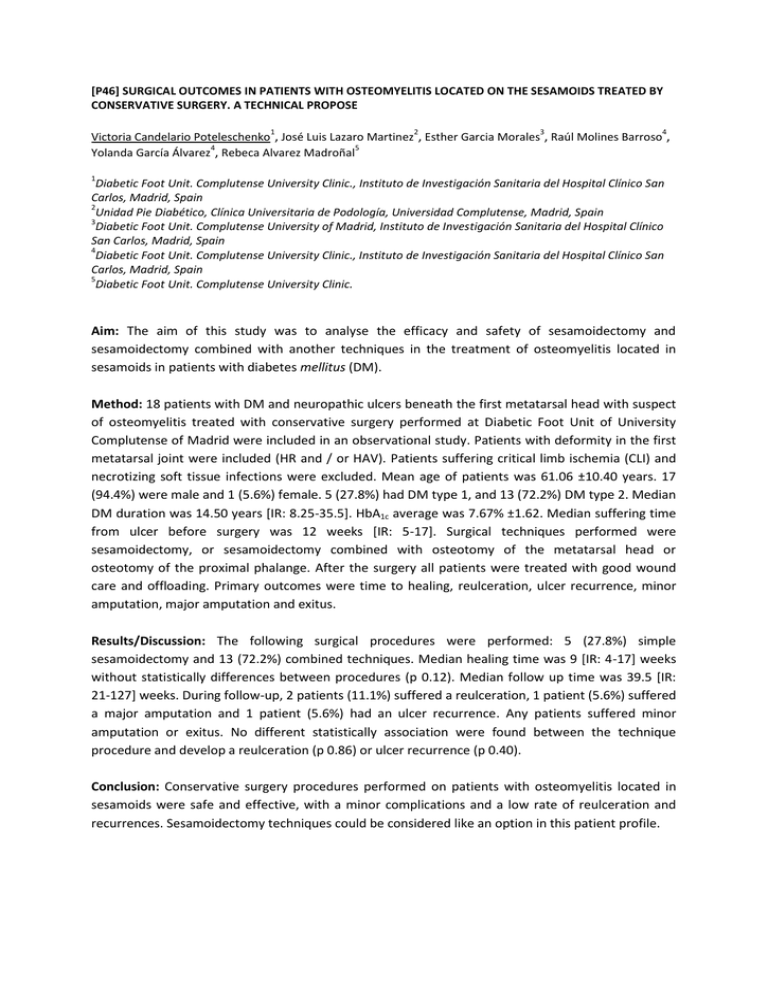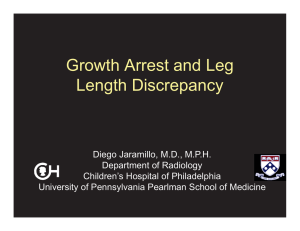Aim: The aim of this study was to analyse the efficacy and safety of
Anuncio

[P46] SURGICAL OUTCOMES IN PATIENTS WITH OSTEOMYELITIS LOCATED ON THE SESAMOIDS TREATED BY CONSERVATIVE SURGERY. A TECHNICAL PROPOSE 1 2 3 4 Victoria Candelario Poteleschenko , José Luis Lazaro Martinez , Esther Garcia Morales , Raúl Molines Barroso , 4 5 Yolanda García Álvarez , Rebeca Alvarez Madroñal 1 Diabetic Foot Unit. Complutense University Clinic., Instituto de Investigación Sanitaria del Hospital Clínico San Carlos, Madrid, Spain 2 Unidad Pie Diabético, Clínica Universitaria de Podología, Universidad Complutense, Madrid, Spain 3 Diabetic Foot Unit. Complutense University of Madrid, Instituto de Investigación Sanitaria del Hospital Clínico San Carlos, Madrid, Spain 4 Diabetic Foot Unit. Complutense University Clinic., Instituto de Investigación Sanitaria del Hospital Clínico San Carlos, Madrid, Spain 5 Diabetic Foot Unit. Complutense University Clinic. Aim: The aim of this study was to analyse the efficacy and safety of sesamoidectomy and sesamoidectomy combined with another techniques in the treatment of osteomyelitis located in sesamoids in patients with diabetes mellitus (DM). Method: 18 patients with DM and neuropathic ulcers beneath the first metatarsal head with suspect of osteomyelitis treated with conservative surgery performed at Diabetic Foot Unit of University Complutense of Madrid were included in an observational study. Patients with deformity in the first metatarsal joint were included (HR and / or HAV). Patients suffering critical limb ischemia (CLI) and necrotizing soft tissue infections were excluded. Mean age of patients was 61.06 ±10.40 years. 17 (94.4%) were male and 1 (5.6%) female. 5 (27.8%) had DM type 1, and 13 (72.2%) DM type 2. Median DM duration was 14.50 years [IR: 8.25-35.5]. HbA1c average was 7.67% ±1.62. Median suffering time from ulcer before surgery was 12 weeks [IR: 5-17]. Surgical techniques performed were sesamoidectomy, or sesamoidectomy combined with osteotomy of the metatarsal head or osteotomy of the proximal phalange. After the surgery all patients were treated with good wound care and offloading. Primary outcomes were time to healing, reulceration, ulcer recurrence, minor amputation, major amputation and exitus. Results/Discussion: The following surgical procedures were performed: 5 (27.8%) simple sesamoidectomy and 13 (72.2%) combined techniques. Median healing time was 9 [IR: 4-17] weeks without statistically differences between procedures (p 0.12). Median follow up time was 39.5 [IR: 21-127] weeks. During follow-up, 2 patients (11.1%) suffered a reulceration, 1 patient (5.6%) suffered a major amputation and 1 patient (5.6%) had an ulcer recurrence. Any patients suffered minor amputation or exitus. No different statistically association were found between the technique procedure and develop a reulceration (p 0.86) or ulcer recurrence (p 0.40). Conclusion: Conservative surgery procedures performed on patients with osteomyelitis located in sesamoids were safe and effective, with a minor complications and a low rate of reulceration and recurrences. Sesamoidectomy techniques could be considered like an option in this patient profile.
